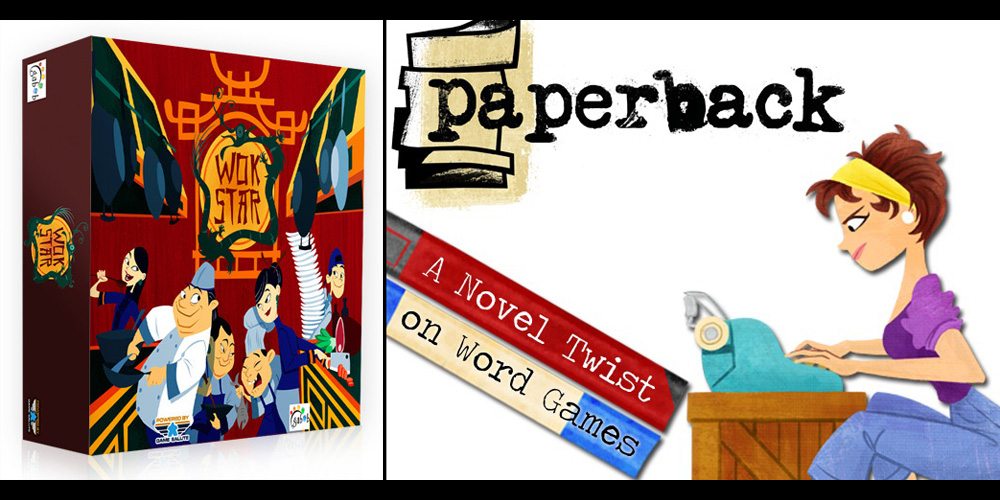You’ve inherited an abandoned family distillery, and now’s your chance to bring your signature family drink recipe to the world. Time to get distilling!
What Is Distilled?
Distilled is an economic and manufacturing card strategy game for 1-4 players, ages 14 and up, and takes about 30 minutes to play per player. It’s currently seeking funding on Kickstarter, with a base pledge level of $55 for a copy of the game, or $85 for an all-in pledge. Even though the game is about brewing alcoholic beverages, there is no alcohol consumption present in the game other than a “tasting” mechanic that allows players to gain money on rounds they don’t sell the spirits that they make.
Distilled was designed by Dave Beck and published by Paverson Games, with illustrations by Erik Evensen.
New to Kickstarter? Check out our crowdfunding primer.
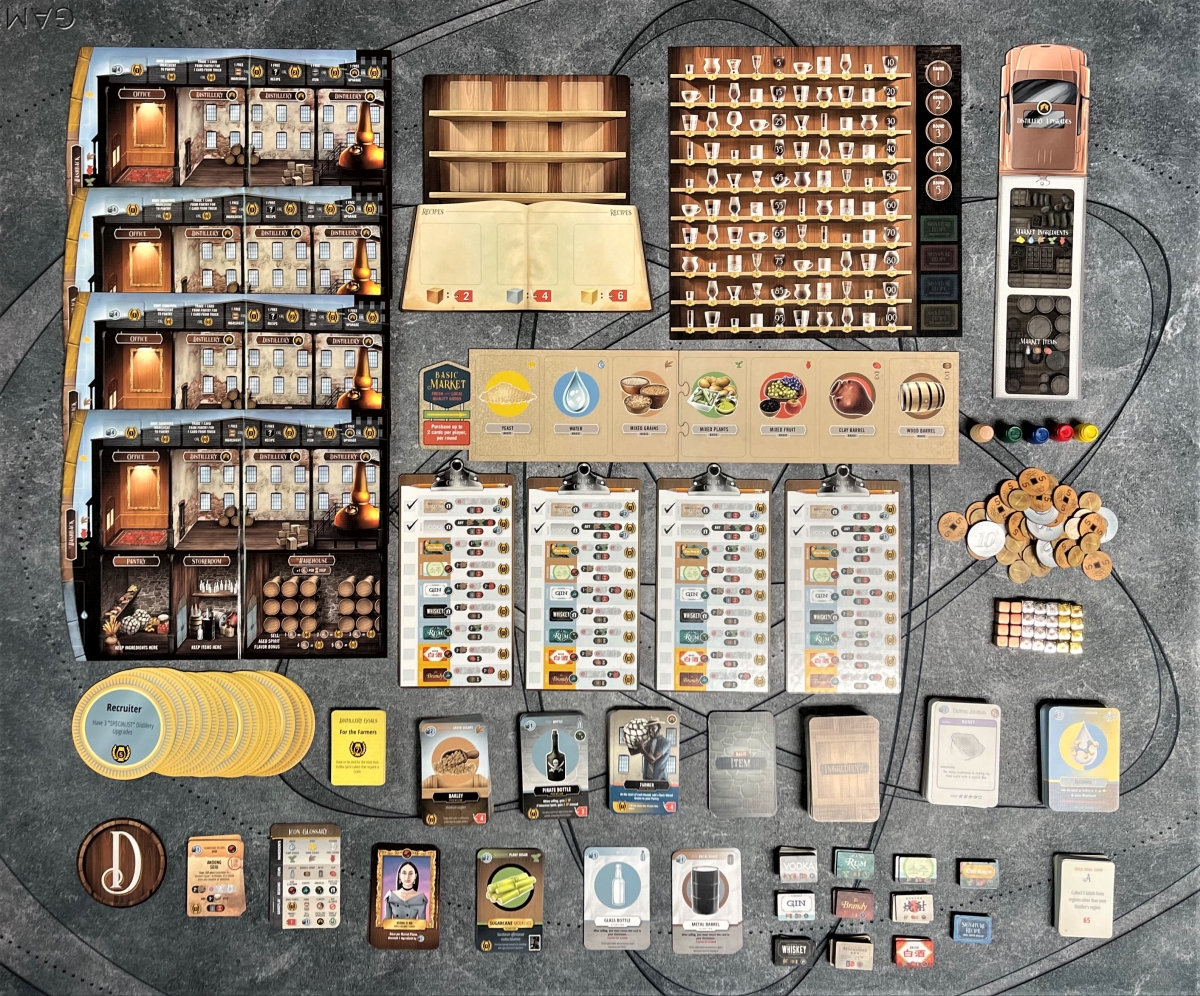
Distilled Components
Note: My review is based on a prototype copy, so it is subject to change and may not reflect final component quality.
Here’s what comes in the game:
- 4 Double-sided Distillery Boards
- 9 Distiller Identity cards
- 9 Signature Recipe cards
- 9 Signature Ingredient cards
- 20 Distillery Goal cards
- 66 Basic Market Ingredient/Item cards
- 36 Premium Market Ingredient cards
- 30 Premium Market Item cards
- 26 Distillery Upgrade cards
- 8 Starting Item cards
- 50 Alcohol cards
- 40 Flavor cards
- 20 Spirit Award cards
- 8 Player Reference cards
- 44 Solo Goal cards
- 4 Double-sided Recipe List cards
- 44 Money Tokens
- 1 Truck Board
- 1 Basic Market Board
- 1 First Player Marker
- 1 Double-sided Spirit Point and Round track
- 1 Double-sided Recipe and Label board
- 52 Spirit Label Tokens
- 28 Bronze, Silver, and Gold Cubes
- 5 Barrels
I got sent a very refined prototype, so while there will be some changes between what I received and what ships as the final product, I expect the quality to remain as high as what I had to review. While all the prototype components came in labeled Ziploc bags, the production version will have custom plastic inserts to store everything.

Each player gets a Distillery Board, which will be where they carry out most of the actions in the game. These are folding boards, with one side for the normal game and one side designed specifically for the shorter introductory game.
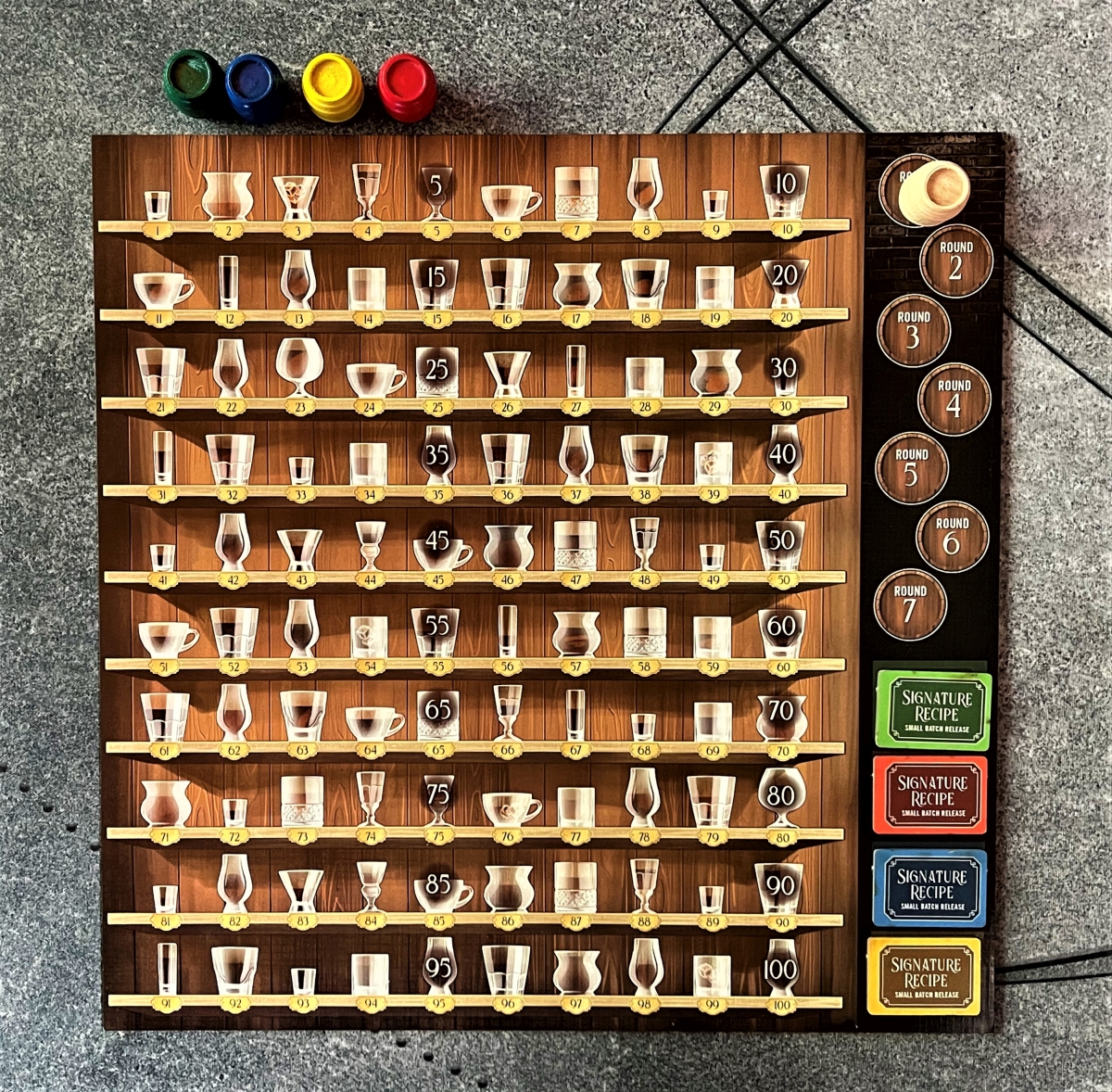
A dual-purpose board tracks the “Spirit Points” (victory points) and rounds using barrels. The board also stores each player’s Signature Recipe Label, which may only be claimed once that player’s Signature Recipe has been made. A separate board holds all the other recipe labels, as well as metallic cubes that are purchased to unlock different recipes.
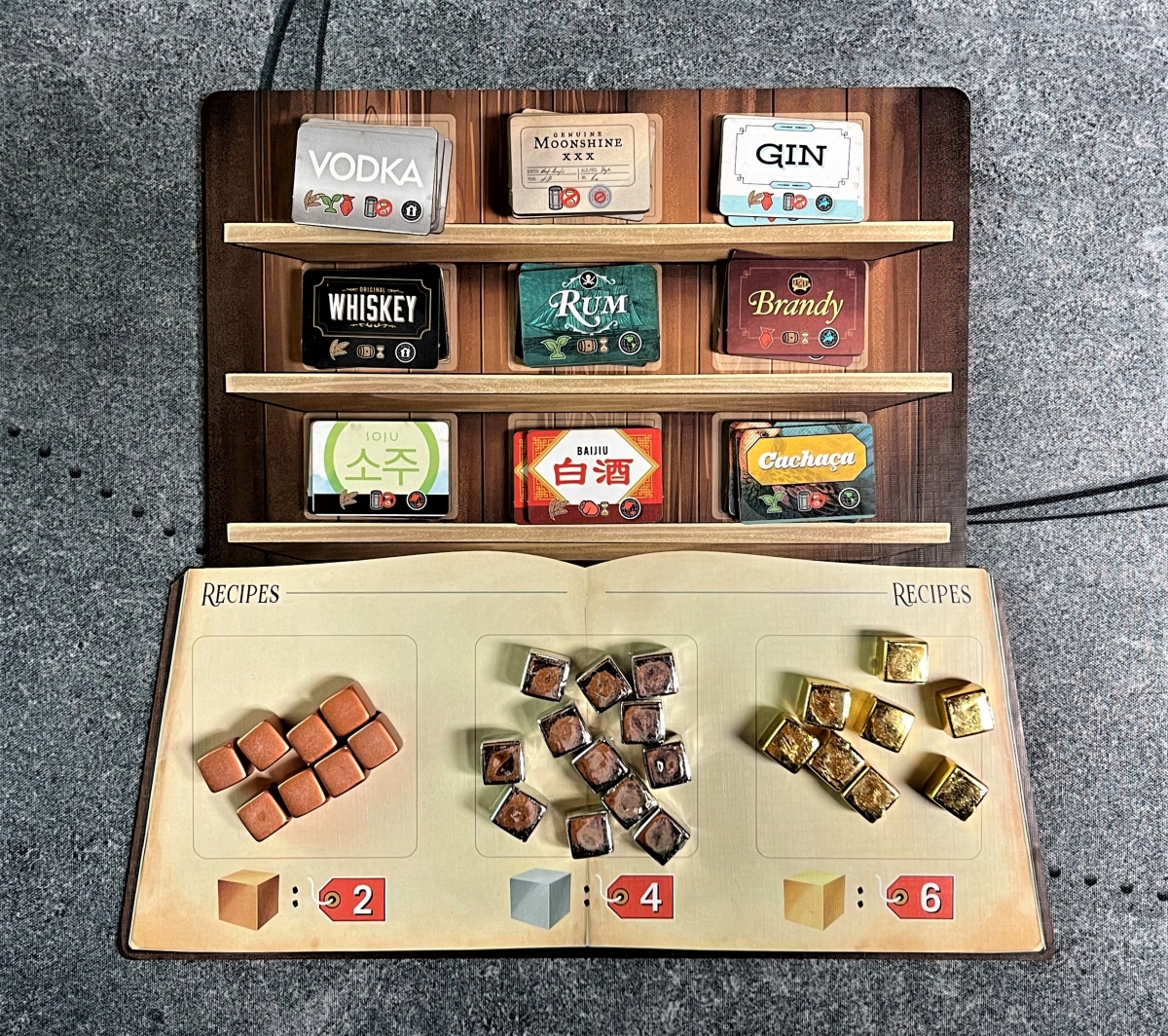
When recipes are purchased, the appropriate cube is placed onto the player’s Recipe List board, marking that particular recipe as known and ready to make. All players start knowing how to make both moonshine and vodka.
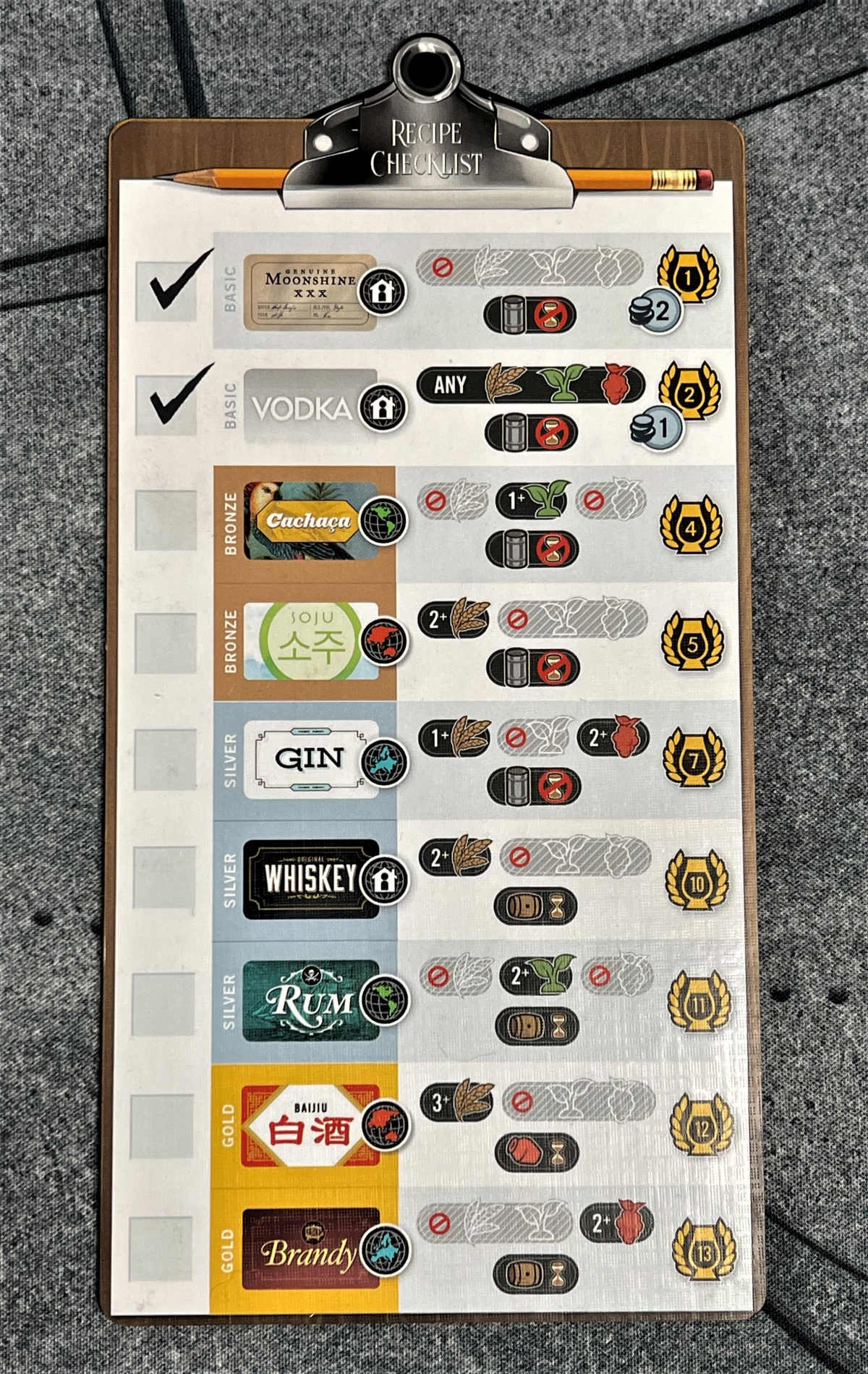
Currently, both the Truck board and the Basic Market board are made from two interlocking pieces of cardboard. I know that the final versions are planned to be one piece each, probably folding. Even though this is just a prototype copy, all of the cards have a very nice linen finish.

How to Play Distilled
You can download a copy of the rulebook here. There is also a free print and play available to try the game for yourself, or you can alternately play online on both Tabletopia and Tabletop Simulator.
The Goal
The goal of Distilled is to make the most Spirit Points (SP) by the end of the game, thereby becoming the Master Distiller.
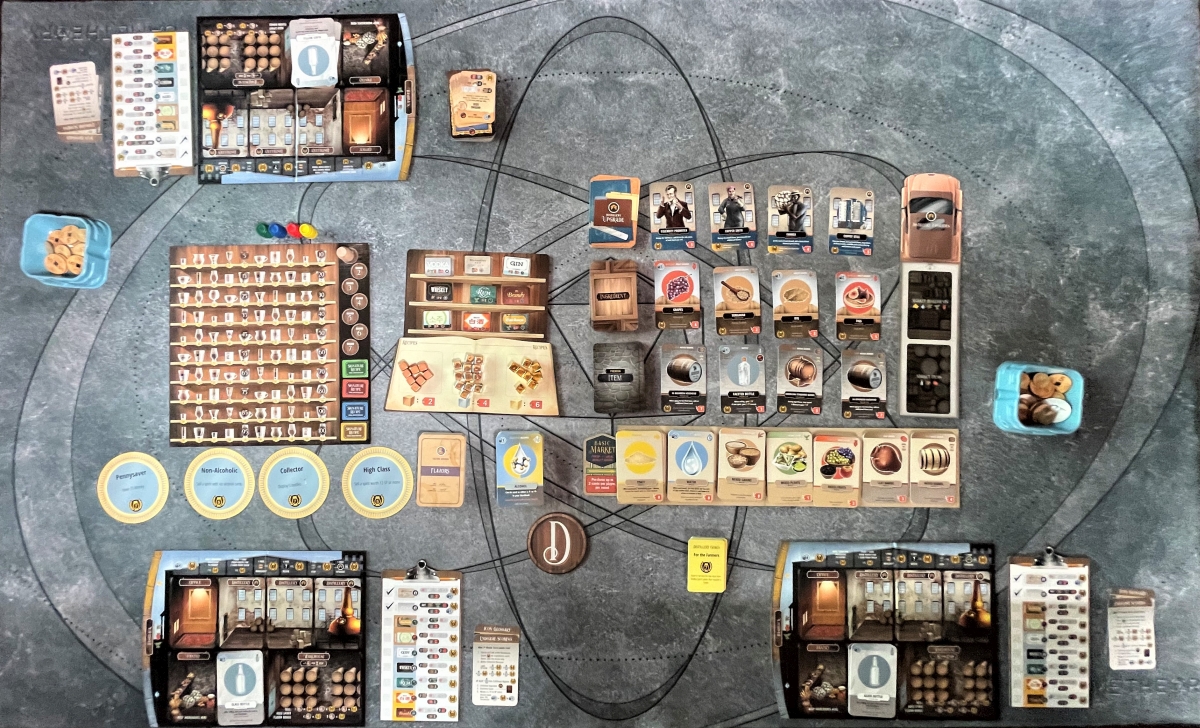
Setup
Note: the following setup instructions are for a standard game.
Start by placing the Spirit Point and Round Track board on the table with the 7 round side face-up. Place a colored barrel for each player near the board, and put the tan barrel on the “1” space of the Round Track. Each player chooses a color. Place a Signature Recipe label matching each player’s color on the label spaces of that board.
Place the Basic Market board on the table, and lay out decks of each Basic Ingredient and Basic Item cards on the matching spaces. Then set up the Premium Market above it, shuffling the three decks of Premium Item, Premium Ingredient, and Distillery Upgrade cards then place them facedown. Lay out 4 face-up cards from each deck in a row, with the Truck board placed to the right of those cards. The Truck board will serve as the discard piles for those three decks.
Shuffle the Flavor cards to create a face-down deck. Place a face-up deck of Alcohol cards next to it.
Place the Recipe and Label board onto the table, with the various cubes in piles on their respective spaces. Take 1 of each Spirit Label per player, except moonshine and vodka which you will take 2 of each label per player. Place them on the shelf spaces on the Recipe and Label board.

Randomly choose a number of Spirit Awards equal to the number of players plus one, and place them face-up on the table. Create a supply of money tokens in easy reach of all the players.
Each player gets a Distillery board, Recipe List, Player Reference cards, and two Starting Items which consist of a Metal Barrel card and a Glass Bottle card. Those cards are placed on the storeroom space of the Distillery board.
Shuffle the Distiller Identity cards and deal 2 out to each player. Shuffle the Distillery Goals cards and deal out 3 to each player. Then randomly determine the starting player, who will receive the First Player marker.
Each player then selects one of the two Distiller Identity cards to keep, placing the other back in the box. The chosen Identity card will get placed in the Office space of the Distillery board. Players take the starting ingredients and money shown on the backs of their Identity cards, as well as the Signature Recipe and Signature Ingredient matching their Identity card. The latter get placed next to their Distillery board.
Finally, each player selects 2 of the 3 Distillery Goal cards they were dealt. They keep those face-down and secret until the end of the game, returning the card not chosen to the game box.
Gameplay
Distilled is played over 7 rounds. There are 4 main Phases to each round, with some actions also taken at the Start and End of each round.
Gameplay starts with the First player, and proceeds clockwise.
Start of Round
If anyone has any “Start of Round” actions on their Identity or Distillery Upgrade cards, these are taken now.
Phase 1: Market Phase
During this phase, players can purchase Recipe Cubes, Basic Ingredient or Item cards from the Basic Market, Premium Ingredient or Item cards, or Distillery Upgrade cards. Prices are shown on the price tags. A player can make as many purchases as they have money to spend, but purchases are made one at a time in turn order. When you are done purchasing, you pass.
Ingredients may go into your pantry or directly into your washback, the distilling space on the left of your Distillery Board.
- Recipe cubes go onto a space on your recipe card list. You may now make this recipe if you have the required ingredients shown.
- Basic Ingredients. There is a limit of 2 times/round that you may purchase a basic ingredient.
- Premium ingredient or item cards. You are limited only by the money you have to spend. Item cards go into your storeroom.
- Distillery upgrade cards. These go into one of the 3 upgrade spaces on your board.
Once everyone has passed, you move onto the next phase.

Phase 2: Distill Phase
This is where you’ll make the one spirit for the round which you will either sell, or put into your warehouse to age. This round can be done simultaneously by all players.
At the start of the phase, you may trade any 1 card with a card in the Basic Ingredient market worth the same price or lower.
Next, you will move any cards from your pantry to your washback, or vice-versa, to distill your spirit. You must have at least one card in each of the three row types in order to distill: Yeast, Sugar, and Water.
Next, add 1 Alcohol card for each Sugar card in your washback. Shuffle all the cards in your washback together to form a face-down spirit stack, then remove the top and bottom cards from that stack and place those cards face-up in your pantry. Those represent the toxic head and tail of the distilling process which are removed when making a spirit.
Reveal the remaining cards in your spirit stack. These are the results of your distillation. Compare the results to your recipe list, and you will choose 1 result that matches any recipes that you know to be the spirit you have distilled that round. Add the appropriate barrel card to the spirit stack, and claim the matching Spirit Label.

Phase 3: Sell Phase
This phase is done in turn order, selling just 1 spirit on your turn. You can sell the spirit that you just distilled, as well as any spirits aging in your warehouse in this round, but you must wait until the turn comes back around to you before selling any additional spirits.
Note: If a recipe has a symbol of an hourglass, it must be aged at least one round. If it has a symbol of an hourglass with a red slash through it, then it cannot be aged and must be sold immediately after distilling.
Here are the steps to selling a spirit:
- Lay out the spirit stack including the barrel and any flavor cards (added during aging), and add a bottle to the stack.
- Count the total sell value from both the cards and the recipe, and take that much money from the supply.
- Count the total number of SP (Spirit Points) from the cards as well as the recipe, and the Aged Spirit Flavor Bonus if the spirit was aged, and advance that many spaces on the Spirit Track.
- Place the label from the spirit onto one of the empty spirit label bonus spaces at the top of your Distillery board, and immediately take that bonus.
- Return all cards: starting metal barrel and glass bottle cards go back in your storeroom, premium market bottles go next to your distillery, basic market cards go back to their respective stacks, and premium market cards go to the truck.

Phase 4: Age Phase
Aging is done in turn order, but you will age all spirits in your warehouse on your same turn. Take the following steps to age a liquor:
- Place the spirit stack, without barrel, face-down into an open warehouse space.
- Draw the top card of the Flavor Deck and, without looking, add it face-down to the bottom of the spirit stack.
- Place the barrel card on top of the spirit stack, and then the label on top of that.
If you have a spirit that was in your warehouse from an earlier round that you are continuing to age, just draw the top card of the Flavor Deck and, without looking, add it face-down to the bottom of the spirit stack.
End of Round
Before the start of the next round, do the following:
- Check to see if anyone fulfilled any of the Spirit Awards. If so, earn the SP shown on the award, and flip it over as it can no longer be claimed. If more than one person fulfilled the requirements on the same round, divide the SP equally, rounding up.
- If you did not sell a spirit that round because you were aging, you can offer a tasting to earn some money. You may move back on the Spirit Point track up to 4 SP, earning the equivalent in money.
Once these steps are complete, the round marker is advanced one space, and the First Player marker is passed clockwise.
Game End
The game ends when everyone has completed Round 7. At that point, everyone gains additional SP from the following:
- Any unsold spirits left in your warehouse. Count the SP for all the cards in the spirit stack, barrel, and recipe.
- Premium Market bottles in your collection.
- Distillery Upgrades that have an SP value on the cards.
- Distillery Goal cards that you have fulfilled.
- Remaining money, calculated at 1 SP/5 money, ignoring remainders.
After everyone advances those additional SP, whoever has the most Spirit Points wins, becoming the Master Distiller.

Solo Mode
Rather than playing against a “dummy” player, the Distilled solo mode has you trying to complete at least 5 randomly determined goals over the course of the 7 rounds of the game, as well as meet or exceed a target score based on the cards you draw for your game. Solo Goals can be of the following four categories:
- Distill goals. You must distill a certain type of spirit to achieve the goal.
- Sell goals. You must sell a certain type of spirit to achieve the goal. Note: spirits used to achieve a distill goal can’t be used to achieve a sell goal, and vice-versa.
- Collect goals. Obtain certain labels or distillery upgrades.
- Earn goals. Complete a certain achievement within a single round, such as completing the round with a certain amount of money.
For full rules on setting up and playing the Solo Mode, refer to the rulebook.
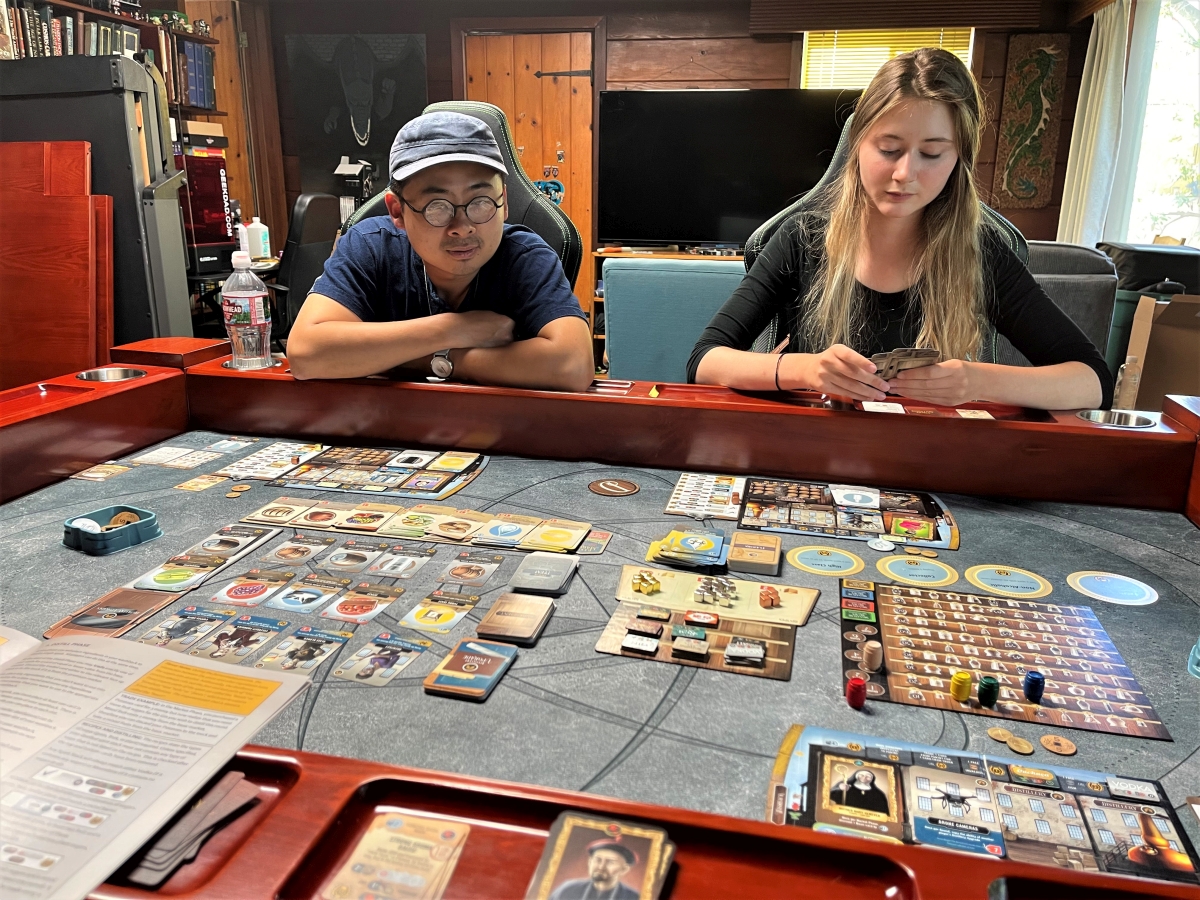
Why You Should Play Distilled
If you take a look at the serious expressions on my friends’ faces in the picture above, it’s because there’s some real strategy involved in the playing of Distilled. Over the course of 7 rounds, you will grow your distillery, starting from very humble beginnings where you only have a few coins to your name, and all you can make is vodka or moonshine. By the end of the game, you’ll be distilling your family’s special recipe, and aging more complex spirits like brandy and baijiu.
The basic round structure for Distilled is easy to both teach and learn. There are a few rules that can be easy to overlook, like the one about being able to trade a single ingredient at the start of the distill phase, but thankfully the rulebook also has a “commonly forgotten rules” section to remind players of these smaller but important details. The real heart of the game is in how you approach each round, so that you can maximize your scoring potential. That will begin with setup, where you decide both on your Identity (i.e., the distillery owner you’ll be playing) and selecting which two secret endgame goals you’ll be pursuing.
Each of the Identities have different starting money and ingredients, as well as a unique special ability that they’ll have throughout the game, and a specific region that they’re tied to. For example, in one of my games I played as Joana Peri de Sousa, who is from the Americas region. She has an ability that gives her an extra money every time she sells a non-aged spirit. In the early game you’ll be selling pretty much exclusively non-aged spirits, so this allowed me to afford some premium ingredients sooner than my opponents.

But that’s only one piece of the puzzle. Out of the Distillery Goal cards that I’d drawn, I kept “Photosynthesis” and “Diverse Portfolio.” Photosynthesis would award me Spirit Points for the most labels that required plant-based sugars… of which Joana’s Signature Recipe was one. Diverse Portfolio would award me Spirit Points for having the greatest variety of labels. So, my overall strategy was to focus on unlocking and distilling plant-based recipes, as well as making a good variety of them.
Being able to purchase Distillery Upgrades allows you to build a mini-engine, which can contribute to your strategy both generally and specifically. Some of the Distillery Goal cards are tied directly to upgrades. And many upgrades can benefit you every turn. “Column Still” allowed me to play a little riskier with my ingredients, as during the Distill phase I only had to lose 1 ingredient, not two. So I never had to push my luck as much as some of the other players when distilling.
While the level of player interaction in Distilled isn’t high, you must still prioritize your purchases during the Market phase, knowing that one or more of your fellow players may be eyeing the same valuable upgrade or premium item. Additionally, at the end of each Market phase, the farthest-right Premium items will all leave the market and get loaded onto the truck. Which actually may be to your advantage, as one of the label bonuses allows you to acquire an item from the truck.
There are also a limited number of labels available per game. If the labels for a recipe run out, you can still distill that spirit, but you won’t have a label available to claim one of the bonuses. And those bonuses can be huge, as some allow you to acquire things like expensive Distillery Upgrades or Premium Items for free. While the Distill phase is done simultaneously, labels are drawn in turn order. So hopefully you’re first player on the turn that somehow everyone made soju.
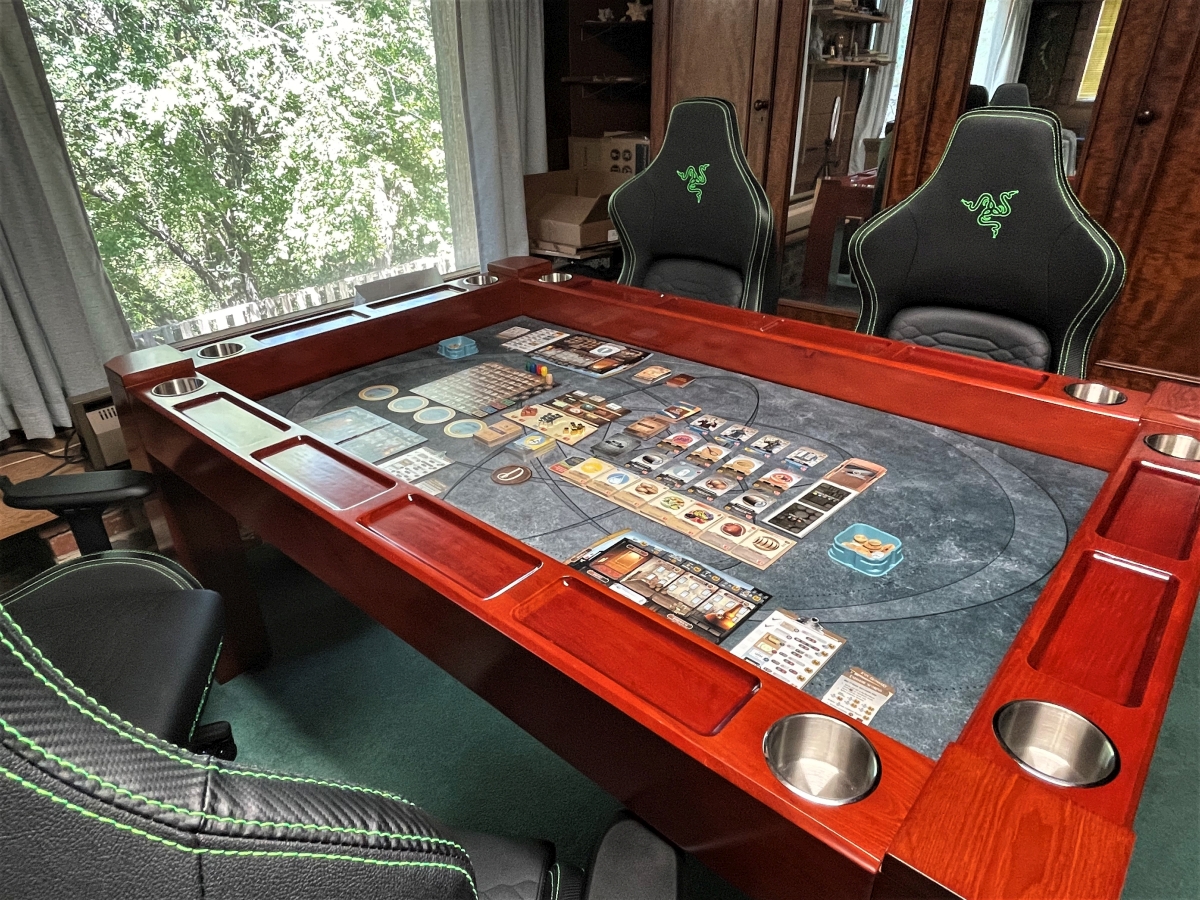
I was very impressed with the quality of the components and the degree of polish on Distilled. Yes, this is a prototype, but (aside from some cards with “placeholder art” emblazoned on them) Distilled feels and plays as good if not better than most games you’ll currently find on shelves. It’s obvious that a lot of work and care has gone into the development of the game. The pacing feels spot on. Seven rounds is enough time to get a small engine going and age two or three spirits, but not so long that the game outstays its welcome. It’s nice that Distilled ships with a shorter 5-round introductory game, but I would argue that it’s only worth playing that when you’re demoing the game. The full 7 rounds seems the perfect length.
While the level of strategy can get intense sometimes, there’s a nice built-in mechanism so that you never feel like you’ve wasted a round. Because everyone knows how to make both moonshine and vodka, you will always be able to distill something each round, even if it’s not the spirit that you’d intended to distill. And, while you will lose two cards from your spirit stack when you distill, you still get to put them into your pantry for a future round, rather than having to discard them. I found this really helped keep player frustration to a minimum when plans went awry, as they inevitably will from time to time in any strategy game.
Unsurprisingly, if everyone at the table is an adult, this is a great game to enjoy with one of your favorite spirits. But that doesn’t mean that older kids won’t enjoy the game too. The theme and the mechanisms in Distilled blend into a harmonious whole, creating a delicious treat for the gaming palate that will be welcome at the table. There’s also a great sense of humor in Distilled, especially in the Flavor cards. When it comes time to sell an aged spirit, it’s well worth having that player read the always funny flavor cards out loud, as if they’re actually doing a tasting. You’ll never forget the first time you end up with a liquor that somehow has acquired the taste of an old rubber tire.
For more information or to make a pledge, visit the Distilled Kickstarter page!
Click here to see all our tabletop game reviews.
![]() To subscribe to GeekDad’s tabletop gaming coverage, please copy this link and add it to your RSS reader.
To subscribe to GeekDad’s tabletop gaming coverage, please copy this link and add it to your RSS reader.
Disclosure: GeekDad received a copy of this game for review purposes.





